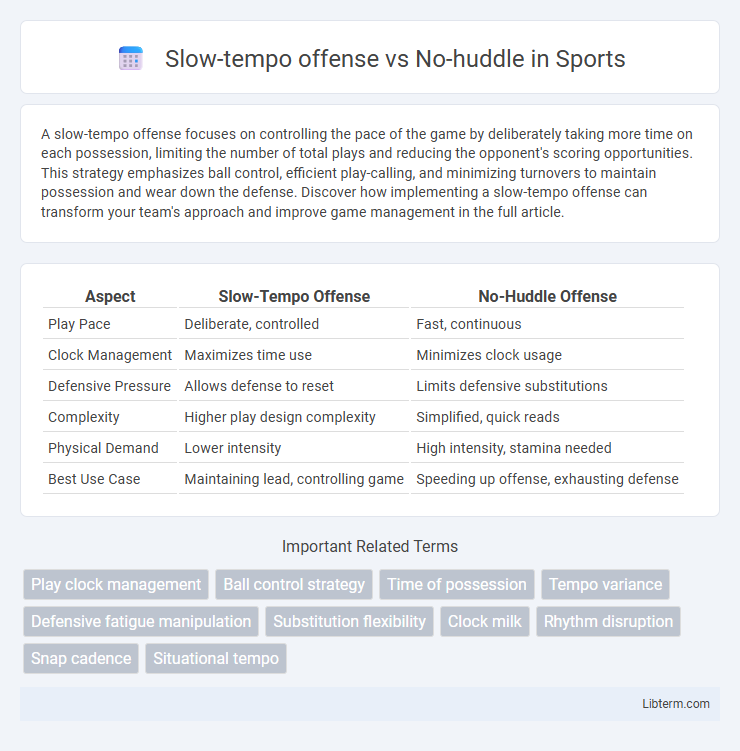A slow-tempo offense focuses on controlling the pace of the game by deliberately taking more time on each possession, limiting the number of total plays and reducing the opponent's scoring opportunities. This strategy emphasizes ball control, efficient play-calling, and minimizing turnovers to maintain possession and wear down the defense. Discover how implementing a slow-tempo offense can transform your team's approach and improve game management in the full article.
Table of Comparison
| Aspect | Slow-Tempo Offense | No-Huddle Offense |
|---|---|---|
| Play Pace | Deliberate, controlled | Fast, continuous |
| Clock Management | Maximizes time use | Minimizes clock usage |
| Defensive Pressure | Allows defense to reset | Limits defensive substitutions |
| Complexity | Higher play design complexity | Simplified, quick reads |
| Physical Demand | Lower intensity | High intensity, stamina needed |
| Best Use Case | Maintaining lead, controlling game | Speeding up offense, exhausting defense |
Understanding Slow-Tempo Offense: Key Concepts
Slow-tempo offense emphasizes deliberate, methodical play-calling designed to control game pace and maintain possession, minimizing turnovers through careful execution. This strategy uses longer play clock management and balanced formations to methodically progress downfield while limiting the opponent's offensive opportunities. Understanding key concepts such as tempo control, clock management, and precision in execution is essential for leveraging slow-tempo offense effectively in football.
No-Huddle Offense Explained: Fast-Paced Football
No-huddle offense accelerates the tempo of play by eliminating huddles, enabling teams to quickly line up and snap the ball, which creates confusion in the opposing defense and prevents substitutions. This fast-paced football strategy enhances time management and increases the number of offensive plays, putting constant pressure on defensive formations. Unlike slow-tempo offenses that focus on ball control and minimizing mistakes, no-huddle offenses prioritize speed, tempo, and exploiting mismatches through rapid decision-making and execution.
Strategic Differences: Slow-Tempo vs No-Huddle
Slow-tempo offenses emphasize ball control and time management, using deliberate play-calling to methodically wear down defenses and minimize turnovers. No-huddle offenses prioritize rapid play execution and defensive confusion by maintaining a fast pace and limiting substitutions, leveraging tempo to exploit mismatches. Strategic differences center on control versus aggressiveness, with slow-tempo focusing on patience and clock dominance, while no-huddle aims for momentum and constant pressure.
Advantages of Slow-Tempo Offense
Slow-tempo offense enhances time management by allowing controlled clock usage, which minimizes the opponent's offensive opportunities and reduces turnovers through deliberate play-calling. It enables better execution of complex plays and adjustments, providing quarterbacks and players more time to read defenses and increase conversion rates on critical downs. The methodical pace also helps maintain player stamina, decreasing fatigue and improving overall team performance late in games.
Benefits of Running a No-Huddle Offense
Running a no-huddle offense significantly accelerates game tempo, preventing defensive substitutions and creating mismatches. The continuous pace increases offensive plays per game, boosting scoring opportunities and exploiting defensive fatigue. Efficient time management also allows for strategic adaptability, forcing defenses to react quickly without time to regroup.
Impact on Opposing Defense: Tempo Strategies Compared
Slow-tempo offense forces the opposing defense to maintain high concentration and discipline for extended periods, wearing down stamina and reducing their ability to adjust quickly. No-huddle tempo accelerates the pace, preventing defensive substitutions and exploiting mismatches through fatigue and confusion. Both strategies manipulate defense timing but differ in pressure dynamics: slow-tempo drains endurance slowly, while no-huddle overwhelms with rapid play succession.
Clock Management: Controlling the Game’s Pace
Slow-tempo offenses excel at clock management by using long, deliberate plays and sustained drives to limit the opponent's possessions and maintain control of the game clock. No-huddle offenses speed up the pace, minimizing time between plays to keep defenses off balance but can risk quicker possessions that reduce overall clock control. Effective clock management hinges on balancing tempo to maximize time of possession while controlling game momentum.
Player Fatigue and Substitutions: Tempo Considerations
Slow-tempo offenses reduce player fatigue by allowing more time between plays, enabling strategic substitutions and better energy management. In contrast, no-huddle offenses increase player fatigue due to continuous play without breaks, often limiting substitution opportunities and demanding higher endurance. Teams must balance tempo with player stamina and substitution patterns to maintain optimal performance throughout the game.
Situational Effectiveness: When to Use Each Offense
Slow-tempo offense excels in managing the clock and controlling the game's pace, making it ideal in late-game situations when preserving a lead is crucial. No-huddle offense thrives in high-tempo scenarios, disrupting defensive adjustments and exploiting mismatches during quick possessions, especially when trailing or seeking to maintain momentum. Coaches strategically deploy slow-tempo to minimize risk and no-huddle to maximize scoring opportunities based on game context.
Case Studies: Teams Excelling with Slow-Tempo or No-Huddle
The San Francisco 49ers exemplify success with a slow-tempo offense, utilizing controlled, methodical plays to dominate possession and reduce defensive errors. Conversely, the Kansas City Chiefs thrive with a no-huddle offense, leveraging rapid play execution to exploit defensive mismatches and increase scoring opportunities. These contrasting strategies highlight how tempo impacts game dynamics, with case studies emphasizing the importance of execution tailored to team strengths.
Slow-tempo offense Infographic

 libterm.com
libterm.com